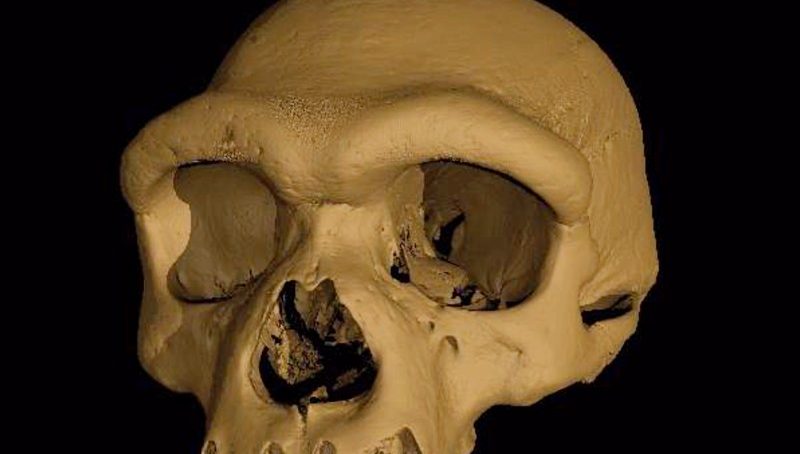
Fossils found in China and Israel dating from around 140,000 years ago are adding to the ranks of hominins that mixed and mingled with early modern humans.
The fossils from Israel hint that a previously unknown group of hominins, proposed to be the direct ancestors of Neanderthals, might have dominated life in the Levant and lived alongside Homo sapiens.
Meanwhile, researchers studying an extremely well-preserved ancient human skull found in China in the 1930s have controversially classified it as a new species, dubbed Dragon Man, which might be an even closer relative to modern humans than are Neanderthals.
But both findings have sparked debate among scientists. The studies are based on analyses of the size, shape and structure of fossilised bones – methods that are subject to individual judgement and interpretation. As is often the case for fossil finds, there is no DNA evidence.
Separating early hominin specimens into unique species, working out if and how they interacted with others, and tracing their evolution are all difficult and contentious: “It’s very messy,” says Jeffrey Schwartz, an anthropologist and evolutionary biologist at the University of Pittsburgh in Pennsylvania.
Since 2000, the view of human evolution during the past half a million years has become ever-more complicated as researchers have added to the list of species in the genus Homo that lived in the Middle and Late Pleistocene. The family tree now includes the Indonesian H. floresiensis, discovered in 2003; Siberian Denisovans, identified in 2010; South African H. naledi, described in 2015; and Filipino H. luzonensis, detailed in 2019.
These species overlapped in time with modern humans (H. sapiens), which are thought to have emerged from Africa and spread into Israel and other regions some 200,000 years ago, and Neanderthals (H. neanderthalis), which had a stronghold in Europe 300,000 years ago and were outcompeted by, or subsumed into, modern humans by around 40,000 years ago.
However, some hominin fossils from this time period still don’t fit neatly into any existing categories. Now, researchers studying some of these odd-ball fossils, found in Israel, think they might have identified a new group of hominins. Physical anthropologist Israel Hershkovitz at Tel Aviv University and his colleagues focused on skull fragments found at the site of Nesher Ramla in central Israel – parts of parietal bones and a jaw, probably belonging to the same individual – that date to between 140,000 and 120,000 years ago.
Conventional thinking is that only H. sapiens lived in the Levant at this time, the team says; the earliest conclusive evidence of Neanderthals being there is from 70,000 years ago. “What we expected to find was Homo sapiens,” says co-author Hila May, also at Tel Aviv University. “At first glance, for sure it wasn’t.” The jaw and teeth were Neanderthal-like, but the skull shape was more archaic – an unusual combination.
The oddity seems to match up with a handful of other fossils found around Israel, some dating back 400,000 years, none of which had previously been classified. “We couldn’t assign them to any Homo group,” says May. “It was a mystery.”
In a pair of studies published in Science on June 24, the group proposes that all of these fossils belong to a newly named hominin population – the Nesher Ramla people – who might have dominated this region for hundreds of thousands of years. The team says the Nesher Ramla people belonged to an unknown umbrella species, rather than constituting a new species themselves.
The Nesher Ramla population seems to have mastered the same stone tools as H. sapiens living in the area. Artefacts found near the fossils suggest that these people napped flints, bringing in material from up to 10 kilometres away, and re-sharpened the tools when needed. Their use of similar technology hints that they lived together with modern humans and perhaps interbred.
But not all researchers agree with the team’s findings. To paleoanthropologist Philip Rightmire at Harvard University in Cambridge, Massachusetts, the skull looks like an “early, rather archaic-appearing, Neanderthal”. Rightmire says he would not be surprised to see Neanderthals in this region at this time.
Hershkovitz and colleagues argue that the Nesher Ramla people could have established early, pre-Neanderthal communities in Europe, injecting archaic genes from Africa or Asia into a species that has conventionally been thought of as evolving in Europe. “Neanderthals are no longer an exclusive European story,” says Hershkovitz.
But Rightmire argues that the flow could have gone in the other direction. “I don’t see any reason why these early Neanderthals, if that’s what they are, couldn’t have come from Europe,” he says.
In China, an assessment of a Middle Pleistocene hominin skull that was unearthed decades ago could also shed new light on our ancestors.
The Harbin skull is an extremely well-preserved cranium that dates to about 140,000 years ago and is thought to belong to a 50-year-old male. The skull was originally dug up in 1933 before being hidden from the Japanese army in a well, and was donated to Hebei GEO University in Shijiazhuang in 2018. The skull is particularly large and thick, with big, squarish eye sockets, low cheek bones, large teeth and a wide pallet.
In work published in The Innovation on June 25, palaeontologist Ji Qiang at Hebei GEO University and colleagues propose that the unique features of the Harbin skull are enough to classify it as a new species. They suggest the species name Homo longi (Dragon Man) after the common name of Heilongjiang Province, Long Jiang (Dragon River), where the fossil was found.
However, naming a new species on the back of a single skull, particularly one that has been removed from its original context and comes with no artefacts, is controversial. “I think that there were more species running around Asia than people have allowed themselves to think about,” says Schwartz. But there isn’t enough evidence to convince him that this skull represents a new species.
The Harbin fossil is one of several odd Middle Pleistocene Homo skulls found in China over the years. In Rightmire’s view, these skulls probably represent what became of some of the early Neanderthals who marched from Europe through the Middle East, China and Siberia, eventually becoming the Denisovans. “These Asian bits and pieces probably belong to the same group as Denisovans,” he says. “I bet that’s what we’re talking about here.” Hershkovitz argues that some of these Asian skulls might better fit into the Nesher Ramla group.
In the study, Qiang and colleagues say that, given the Harbin skull’s similarity to some early H. sapiens fossils, H. longi might be an even closer relative to modern humans than Neanderthals are. But Schwartz thinks some of these fossils have been inappropriately lumped into the H. sapiens category. “Many of these fossils are very, very different from each other,” he says.
Overall, the current hominin classifications make little sense, argues Schwartz, because they bundle too much diversity together into species such as H. sapiens. “I think we should start from scratch,” he says. “Some people aren’t bold enough to say: ‘Let’s look at everything from the beginning.’”
- A Nature magazine report











